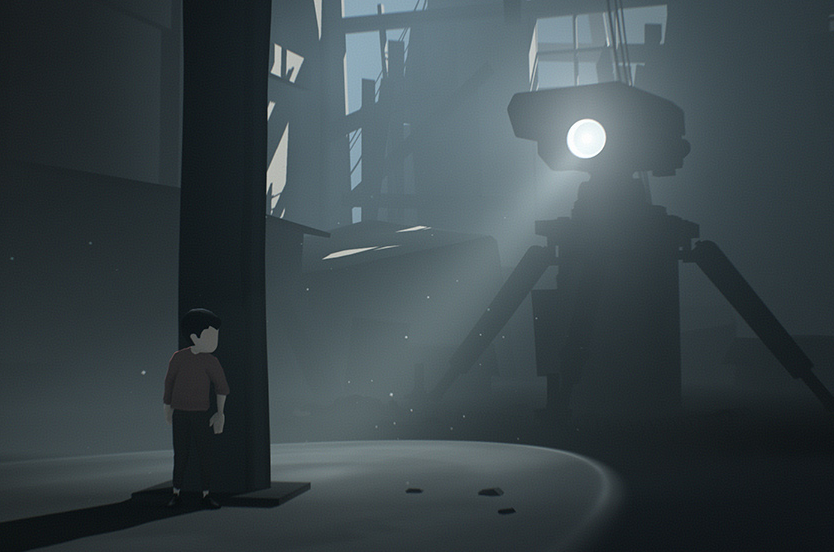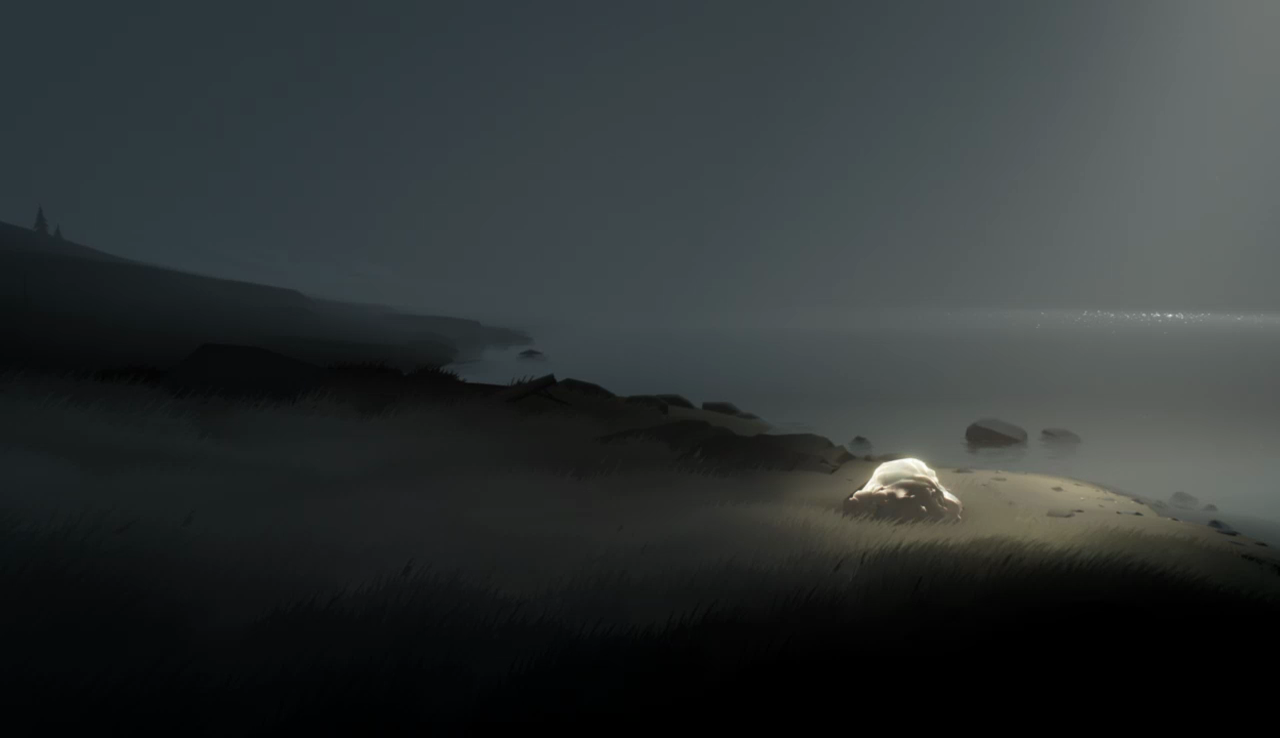
“Have you got to the bit where, y’know, the thing happens?” “With the pig?” “No.” “The underwater thing?” No, I mean the THING, thing.” Inside is the kind of game you want to talk to other players about, but have to approach with caution so as not to rob the game of its grim surprises. Released earlier this week, it’s the spiritual successor to Limbo, every bit as artsy, and probably even more bleak. You can read Andy Kelly’s review here, but this page will serve as a place to discuss our extended thoughts on the game, the main story beats and various endings. As such, it’s going to be absolutely lousy with spoilers. So, SPOILER WARNING, proceed no further if you have any intention of playing Inside at some point in the future. But if you have finished it, or just want to hear people talk about its secrets, then let’s begin. And, of course, please let us know what you made of the game in the comments!
Tim Clark: I guess the place I’d like to start is with the end. Whilst I wouldn’t go so far as to say the ending of Limbo was exactly upbeat, it felt like it tied a fairly neat bow on proceedings, in a quasi-Lynchian, “time is a flat circle”, sort of way. But with Inside’s main ending, I came away sort of shell-shocked and definitely not sure of what to make of it. Obviously everything is coloured by the big twist which happens a little bit beforehand [FINAL SPOILER WARNING] when the boy you’ve been controlling gets slurped up into this monstrous ball of flesh and limbs which you then take control of. Actually, that’s really where we should start. Did any of you see that coming? How did you react to it?
Chris Livingston: I can’t imagine anyone saw it coming. No one is solving crate puzzles for an hour and then suddenly says “Oh, I bet this game ends with me becoming a leggy-armed flesh-blob. It’s so obvious.” And I have absolutely no idea what it means. I thought it was fantastic, though, after a game where you’re essentially powerless to then be able to smash through walls and destroy things and be more monstrous than anything else you’ve encountered. Very cathartic. I liked all the special sections of Inside, like when you’re the monster blob or when you’re controlling an army of, I don’t know what to call them. Husks? Husks. And when you’re in the submarine. By far those were the best parts. Any departure from simply pulling levers and pushing crates and being a tiny boy who can be horribly mutilated by anything were definitely welcome.
Tim Clark: You are of course right. I didn’t see it coming at all. And yes, everything up to that point had been so utterly relentless. The boy is constantly in peril, and each escape only presents some new horror, so being able to turn the tables was… I don’t think cathartic is the right word. Because ultimately he’s stuck in the flesh-blob that looks like it’s rolled out of the orgy scene from the movie Society. It’s hard to paint that as any sort of victory. Even more so when the final shot is so ambiguous. You bust out of the facility, tumble down this forest hillside, and end up resting on a beach. A lonely beam of sunshine dappling your frankly disgusting, quivering, body. Yay, I guess. How did you make sense of the back story? I was torn between it just being this awful totalitarian state where people are being experimented on, but the fact they were rounding people up made me think it was a recent development. So maybe aliens. Does the exact premise even matter?
Chris Livingston: I’m okay without a happy ending, I think because I didn’t really empathize much with the kid. In Limbo, I felt bad for the kid, I wanted him to be okay, but I didn’t really feel attached to the kid from Inside. I don’t know why. I think because the kid in Limbo had a huge head. There’s something about a figure with a giant noggin that makes them more sympathetic. As for the premise of Inside, I don’t know. I’m not sure there’s a concrete story that would explain things, though aliens at least gives us a lot of wiggle room. Could it be a symbolic take on a little boy going to a public school? Adults are oppressive jerks, you’re always being watched and scrutinized, little girls are terrifying, there’s mind control and too many tests and when you finally escape you’re just a goddamn mess. I don’t know where the brutal shockwaves come in. Maybe his dad made him join the rugby team.
Andy Kelly: One of the most interesting moments for me was, when escaping the facility as the flesh-blob, one of the scientists seems to help you. You throw one of those pneumatic crates at him and he activates it, giving you the means to access to the next area. But it doesn’t seem like he’s someone who’s taken pity on you; he’s with other lab-coated dudes who are observing what’s happening. No one’s stopping him. And then there’s the room where there’s a crowd watching, as if your escape was somehow planned or anticipated. The way they study you from afar, inquisitive, suggests that while they’re definitely scared of your sudden sentience, they’re also fascinated by it. Of course, if they created you, it makes sense that they would be.
Tim Clark: Yeah, I wasn’t sure about that at all. I thought maybe they just wanted you out of the facility so you’d stop smushing them. But then that scene also had a “you can make it, pal” kinda vibe to the scientist guy’s animation. Man, the animation is so good. So precise.
Chris Livingston: I was pretty fascinated by the workers. A couple of them had kids of their own. You can see them holding hands at one point. And in one section you open this giant hatch in the floor right next to some of the workers, and one protectively pulls another back. So, whoever or whatever they are, they aren’t entirely soulless monsters, which is interesting.

Tim Clark: Have any of you checked out the special ending you get from finding the collectible gizmos that look like sea mines? If you get them all this happens. I suppose him unplugging himself from the brain control Matrix that is the game, with you as the controller, and becoming a zomboid, is a comment on agency and all that jazz. But I actually found it less satisfying than the almost opaque (in terms of meaning) blob-on-a-beach ending. I think the reason I like that ending so much is precisely because it resists comfortable explanation, so I keep coming back to it.
James Davenport: I actually thought the blob ending was kind of sweet. (I’ll pack my things, Tim.) But really, I got the impression that in Inside’s messed up future scenario, the dummy people represent a commodified, expendable working class. They’re run through a factory line, tested for defects (how about that rhythmic Simon Says ‘puzzle’ early on?), experimented on in every conceivable way—I’m remembering the part where bodies are suspended in water in that strange reverse gravity scenario—and ultimately subsumed by the blob thing, which seems to be controlling the kid. I saw the blob’s escape as their inevitable revolution, which, as Andy noted, seems to have been anticipated by the scientists. So here’s this horrifying, traumatized mass of people desperately making their escape, moaning in agony and tripping down every incline through a final level that may just be a final test. It’s sad, funny, and horrifying all at once.
To me, it was pointing out the failures of revolution, how a class or race or whatever it may be comes out on the other side when facing a huge social or political power. Short answer: not without bumps, bruises, and plenty of generational trauma. I know, I’m getting a bit middle-school-english right now, but Inside feels designed as an impressionist game, and that’s what I came away with. Heck, the more I try to nail Inside down, the less I like it. Summarily, in the end they escape and get to rest with the sun on their back(s) and a cool breeze blowing by to the white noise of the water before biting the collective dust. In such a unrelentingly bleak game, it felt like a relief, a victory with a huge, questionable cost.
Samuel Roberts: As soon as I called the big blob thing ‘Flesh Katamari’ in my head, I couldn’t shake that connection.
Tim Clark: I also want to talk a little about the pig puzzle early on. It’s such an elegant solution—you have to time scramble back and forth across the pig’s back—that it summed up the specialness of the game for me. Because initially I had no idea of why I couldn’t escape, and then instantly it was obvious. It’s also something that wouldn’t be amiss in a traditional platformer, but I love that Inside never repeats the trick. Aaaaaand then afterwards you pull the poor bastard’s tail off, at which point I was all like “whut?” again.
James Davenport: Takes me back to my FFA days.
Andy Kelly: It’s not actually its tail you pull off; it’s a parasitic worm thing that seems to be controlling it. And it’s actually lodged inside its bumhole. Lovely. Notice how the pig becomes docile when you remove it. Some people have suggested this is a direct link to Limbo, which had similar mind-controlling worms. Whether this means both games share a universe, or it’s just a nod by the developers to their last game, I don’t know. Interesting, though
Keep up to date with the most important stories and the best deals, as picked by the PC Gamer team.
Chris Livingston: My favorite puzzles were the ones involving the armies of husks. They were very creepy the way they’d crowd around you, and I could just imagine their cold clammy flesh. But I was also fond of them, the way they’d pick you up, and catch you when you jumped or fell onto them. I think I was so desperate to have allies in such a grim world that even brainless, possibly even dead-but-animated people felt welcome. I hated leaving them behind.
One thing about a lot of the puzzles I didn’t care for was I was often halfway through solving them before I even know what kind of solution I was looking for. I’d walk into a room and there would be a lever, so I’d pull it, or a box so I’d push it, but a lot of times I was doing those things because they could be done, not because I had worked out what they did. I much prefer puzzles where you can look at them for a while before you start them, and get some idea of what they want from you. There’s not really a lot of those in Inside.
James Davenport: There really aren’t. I think Playdead wants to turn you into a monster and treat the boy avatar as a means to an end. I’d always get antsy before a puzzle because I knew I’d have to throw the little guy down a pit or make a suicide swim just to find a button to hit. I never wanted him to die because the violence has very little fanfare. He’s just dissolved by a massive soundwave or ripped apart by a pack of dogs without a music cue or dramatic camera zoom. That doesn’t mean it makes the puzzle design less frustrating. My favorite scenarios were the ones that gave me just enough wiggle room to react and prevent unnecessary deaths. The pig butt scene comes to mind. Babe bowled me over once or twice, but I figured it out shortly after. Same with the soundwave bit. The long-haired underwater person though—it was really effective at first, probably the second best reveal of the game for me, but some of those bits require a ton of trial and error (and drowning), which sort of nullified the initial shock of it all.
Samuel Roberts: I think with the underwater creature in particular, Playdead wisely doesn’t dwell on any one particular idea for too long. There was still palpable relief when I knew I could go back in the water without having that thing grab me, even though I’d seen that death animation a hell of a lot. Its brevity is part of its strength in that regard.
Chris Livingston: I would say I liked Inside better than Limbo (though I liked Limbo). I found Inside more interesting and intriguing visually, and—I'm sure this won't win me any internet points—I found it easier than Limbo, and I like when platformers are challenging without being frustrating. There was only one sequence that stumped me enough to make me stop playing for a bit. I kind of appreciate that.
James Davenport: Good thoughts, everyone. I’d say we should bring it in for a group hug, but if Inside has taught me anything at all...
The collective PC Gamer editorial team worked together to write this article. PC Gamer is the global authority on PC games—starting in 1993 with the magazine, and then in 2010 with this website you're currently reading. We have writers across the US, UK and Australia, who you can read about here.


